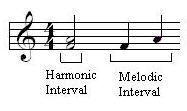|
Part I:
Intervals
There are two types of intervals. A harmonic interval
is playing two tones simultaneously. A melodic interval is two
tones played in succession.

An interval in most basic terms is the distance
between two notes. There are many types of intervals, and theoretically
it extends indefinitely (since you can pick any two notes and there’s
really no limit to how high the second note it). However in practical
usages, there is no application for anything past the second octave
(some modern composer use chromatics to achieve chords made up of all
twelve tones, which spans into the fourth octave).
One last term to know is a step. There are
technically only two types of steps. A half step represents the
difference between two successive notes. For example, going from C to C#
is a half step. Going from E to F is also a half step. As long as no
other note (including black keys as well as white keys on the piano)
exists between the two compared notes, it’s a half step. In numerical
format it is written as “½”.
A whole step represents the difference between two
notes on a piano with a note included in between. C to D is a whole step
(C# is in between). E to F# is a whole step (F is in between). A half
step is commonly represented by a “1”.

Below is a chart listing the melodic interval name, the
step difference, and an example using notes.
Octave One
|
Interval Name |
Step Difference |
Total ½ Steps |
Example |
|
Perfect Unison (Perfect First/Diminished Second) |
0 |
0 |
C and
C |
|
Minor
Second |
½ |
1 |
C and
C# |
|
Major
Second (Diminished Third) |
1 |
2 |
C and
D |
|
Minor
Third (Augmented Second) |
1½ |
3 |
C and
D# |
|
Major
Third |
2 |
4 |
C and
E |
|
Perfect Fourth (Augmented Third) |
2½ |
5 |
C and
F |
|
Tritone (Augmented Fourth/Diminished Fifth)) |
3 |
6 |
C and
F# |
|
Perfect Fifth |
3½ |
7 |
C and
G |
|
Minor
Sixth (Augmented Fifth) |
4 |
8 |
C and
G# |
|
Major
Sixth (Diminished Seventh) |
4½ |
9 |
C and
A |
|
Minor
Seventh |
5 |
10 |
C and
A# |
|
Major
Seventh |
5½ |
11 |
C and
B |
|
Perfect Octave |
6 |
12 |
C and
C |
Octave Two
|
Minor
Ninth |
6½ |
13 |
C and
C# |
|
Major
Ninth |
7 |
14 |
C and
D |
|
Minor
Tenth (Augmented Ninth) |
7½ |
15 |
C and
D# |
|
Major
Tenth |
8 |
16 |
C and
E |
|
Perfect Eleventh |
8½ |
17 |
C and
F |
|
Augmented Eleventh (Diminished Twelfth) |
9 |
18 |
C and
F# |
|
Perfect Twelfth |
9½ |
19 |
C and
G |
|
Minor
Thirteenth (Augmented Twelfth) |
10 |
20 |
C and
G# |
|
Major
Thirteenth |
10½ |
21 |
C and
A |
|
Minor
Fourteenth |
11 |
22 |
C and
A# |
|
Major
Fourteenth |
11½ |
23 |
C and
B |
|
Perfect Fifteenth |
12 |
24 |
C and
C |
*Note that in the second octave, the “C to D” for example
isn’t the same “D” as before. You are moving chromatically up the tones
so it’s the “D” one or two octaves away.
There are many applications for each one of these
intervals in all forms of music. Even the highly dissonant minor second
is used in a variety of places. This concludes the lesson on intervals.
|

